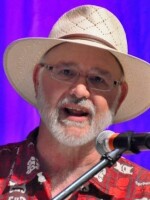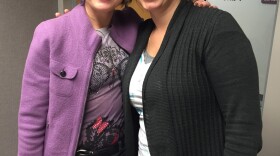The Community Foundation of the Ozarks Celebrated its 43rd anniversary June 18th, and for this edition of Making a Difference; Stories of Hope and Help, the Foundation’s 1st two paid employees are here to talk about their early days in the office.
Producer Mike Smith: "From its founding by the Greene County Estate Planning Council in 1973, to the Fall of 1988 when Jan Horton was hired as Executive Director, and the Spring of 1989, Suzy Gray, her administrative assistant, the Community Foundation of the Ozarks had no employees, nor affiliates, and was operated by volunteer committees of men and women from the Estate Planning Council.
By the time Jan Horton and Suzy Gray were hired, the Community Foundation of the Ozarks had charitable holdings of 1.5 million dollars, and had awarded around a half a million dollars in grants and distributions. In June 2016, the 43rdanniversary of the CFO, the foundation’s charitable grants and distributions, have topped 260 million dollars.
Jan Horton remembers the first official CFO office space well, as it was in her home:

Jan Horton: “It was a red Typewriter.”
Suzy Gray: “It was beige. (laughter) Do you remember we used that typewriter to make pink cards for meeting notices. Now it’s all done with E-mail, but it was such a production back then.”
Jan Horton: “We are not the early days of the Community Foundation Suzy. There was 15 years of very hard work that went in establishing it, getting it going and publicizing it. Fortunately it was the Estate Planning Council that came up with the idea to keep those charitable dollars local. That group, for 15 years, worked hard to keep it going. Then enter us and the RED IBM typewriter, (laughter) that I bought at a garage sale after I said yes, I would work for the CFO.” (laughter)
Suzy Gray: “When I first started I was only working 4 hours, so we were one and half-staff. I was the half.”
JH: “Of course you had records to keep, a lot of records. That usually occupied most of your time.”
SG: “You started out with a Macintosh computer that was given to us through an Apple program. My first computer was gifted to us by Hearld Ambler. Do you remember when we won a new copy machine at that open house? That was so great because we were using an old copier that was given to us by KOZK, and if KOZK gave it to us, it was probably pretty well used by then. (laughter) That was a real wind-fall for us when we got the new copy machine. Just to give you an idea of where we were when you stepped in to that position; the foundation had charitable funds totaling 1.7 million dollars, and now we have over 250 million dollars. When you started, we had 30 charitable funds started by individuals. Now we have over 3000.”
JH: “And also the process by which we revitalized. And I don’t like to use that word because of the 15 years which preceded our employment were hard working years getting it going. And they had a really great program..”
SG: “Right, and I looked back in the (foundation) Minutes yesterday and they called it their Expansion Program. That was their goal, to expand what the Foundation was doing beyond what they could do as volunteers. We had of course when you started, no staff. Now we have 18. We had no office. Now we have offices in 3 cities.”
JH: “Our own building.”
SG: “Right, our own building with our own boardroom. When we first started, we would have to go find a board room to meet in.”

JH: “Mostly banks.”
SG: “Yes, mostly banks, and Mary Kay’s building, Mary Kay Meek, and I think we had some meetings at John Courtney’s too. But that was interesting always finding a board room. And we had (at that time) none of our affiliates, and you were instrumental in getting the first one started in Nixa (Mo).”
JH: “We could go on all day about the affiliates because there are 49 of them now, (as of 6/30/16) and Nixa was the first one. There are 2 things I learned right off the bat about the Community Foundation of the Ozarks. One is an annual report is your best publication tool. It puts you in the same field as a bank or an investment company. A safe and secure entity. The second thing I learned was, when you talk to donors, you want them to A, know you. B, love you. And C, trust you.”
SG: “And I think that’s what you brought to the table, in that you really did make the Foundation go. Up until the time you stated, they had awarded $500,000 in grants out to the community. Now, we have awarded over 260 million dollars in grants and distributions that have gone out for the benefit of folks here in southern Missouri. Dorothy Weaver walked in the office one day…(laughter)”
JH: “(laughter)…We had a fabulous fund that was to provide braces for young people with malformed teeth. Dorothy had started it in memory of her husband (Charles) when he died. He was an orthodontist. The applicants had to say why they wanted braces, and we would sit and cry when we read those letters. The stories we would hear from those kids…Well one day, the fund establisher, Dorothy Weaver, walked in to our office and plunked a diamond ring down on the conference table and she said, We Need More Money in This Fund and I Want to Sell This Ring and Put it in the Fund. To me that’s the height of dedication.”
SG: “So sweet. One of my favorite things is working with our donors because you really see how much they care and how passionate they are about the things they want to do charitably. I have a quote from Marion Wright that I’d like to read. She understood the necessity of unrestricted funds, and established a fund that was unrestricted so it could meet the most important needs in our community. Her quote is: An Endowment Fund is Like a Spring Filling a Pond. It Continues to Fill Over and Over Again, and Doesn’t Disappear…I think that’s beautiful.”
JH: “Oh it is beautiful, and so few words to get across such an important concept. We saw ourselves, after our earlier challenges, as having a leadership role in the community, so we convened a groups of people to meet and talk about the unmet needs in our community, and I became more and more reliant on you, Suzy. You can do anything, really. A rock, from the first day in the office. Someone I could lean on and trust, a friend more than a co-worker all these years. I couldn’t have done it without you, absolutely positively. And now you’re still my friend…”
SG: “And, I value that so much. When I first started, I didn’t know as much about Springfield and the community even though I’ve been a resident most of my life. And it probably took me 9 months before I really knew what a community foundation was after I got there..(laughter) That’s what (former CFO President) Gary Funk used to say… But (with emotion) you opened up so many doors for me, and I just really appreciate it.”
JH: “And here I am…You’re opening doors for me now, so it’s a true partnership.”
SG: “Right, it goes both ways…”
JH: “I love you, Suzy.”
SG: “I love you too…”
Producer Mike Smith: “Jan Horton, who would also serve the Community Foundation of the Ozarks as its first President, is now President Emeritus of the Foundation. Suzy Gray is the CFO’s CFO, the Chief Financial Officer keeping track of the Foundation’s 250 million dollars in charitable funds, which by the way, is 248.3 million more than when Jan and Suzy first came to work for the Community Foundation of the Ozarks.
For information about the Community Foundation of the Ozarks, cfozarks.org







